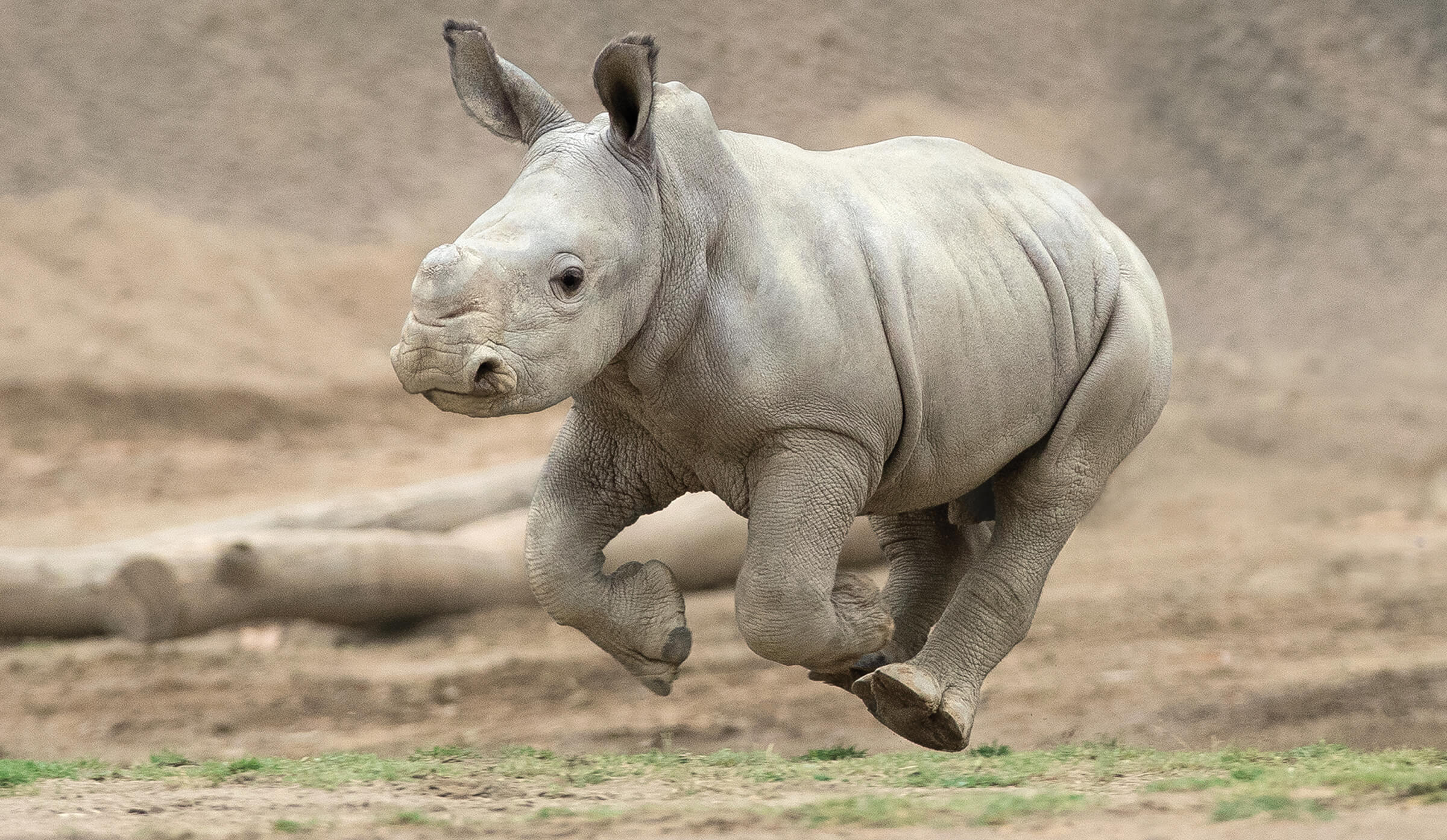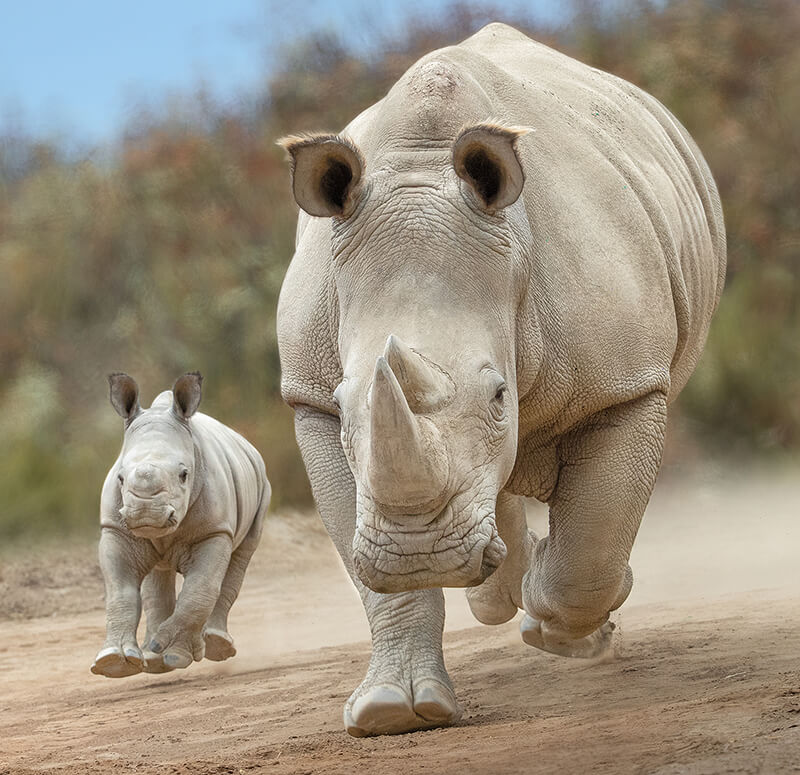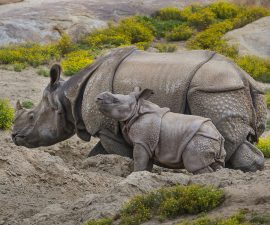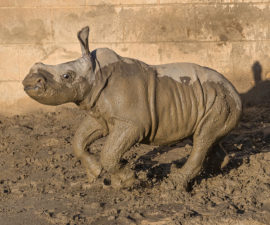I’ve been so fortunate to have a front row seat to Victoria’s pregnancy and Edward’s birth and development. As a wildlife care specialist at the Nikita Kahn Rhino Rescue Center, I get to work with the rhinos and scientists every day. Witnessing groundbreaking science unfold in the name of rhino conservation is incredible.
BY Jonnie Capiro
Photography by Ken Bohn
Victoria Seemed “Different”
On Friday, July 26, 2019, the wildlife care specialist team was convinced that Victoria would have her calf by the end of the weekend, if not sooner. She just seemed “different.”
All our teams were notified and put on stand-by—veterinarians, wildlife care specialists, scientists, public relations, the executive team—everyone. Nothing happened Friday evening, so when the overnight wildlife care specialists showed up for their shift, I went home at my scheduled time. With all the anticipation, it was hard for me to fall asleep. But eventually I did, and there was no “it’s happening!” phone call in the middle of the night.
The next day, Victoria seemed the same—restless, a little grumpy—but she showed no signs of imminent labor. We had wildlife care specialists monitoring her around the clock, but otherwise, it was business as usual.

THE MOM TO BE
During her 16-month pregnancy, both Victoria and her baby were monitored by a talented team of wildlife care specialists, veterinarians, and experts.
The Big Day
On Sunday, Victoria was especially restless and impatient. She didn’t want to be near the other rhinos at all. For most animals, including rhinos, that is a sign that labor is imminent. She also didn’t want to eat her hay, which is unusual for her.
I called the veterinarians to make sure they were up to date with Victoria’s progress. We thought we had several more hours before anything happened, but I moved Victoria into the maternity area, just in case.
When I examined Victoria, I could tell she was in the early stages of labor. I radioed the veterinarians to let them know that Victoria was progressing quickly—much more quickly than we had anticipated. The vets and other wildlife care specialists came running. They helped me move Victoria out of the birth area so that we could add lots of extra hay to the floor. It made a fluffy bed.
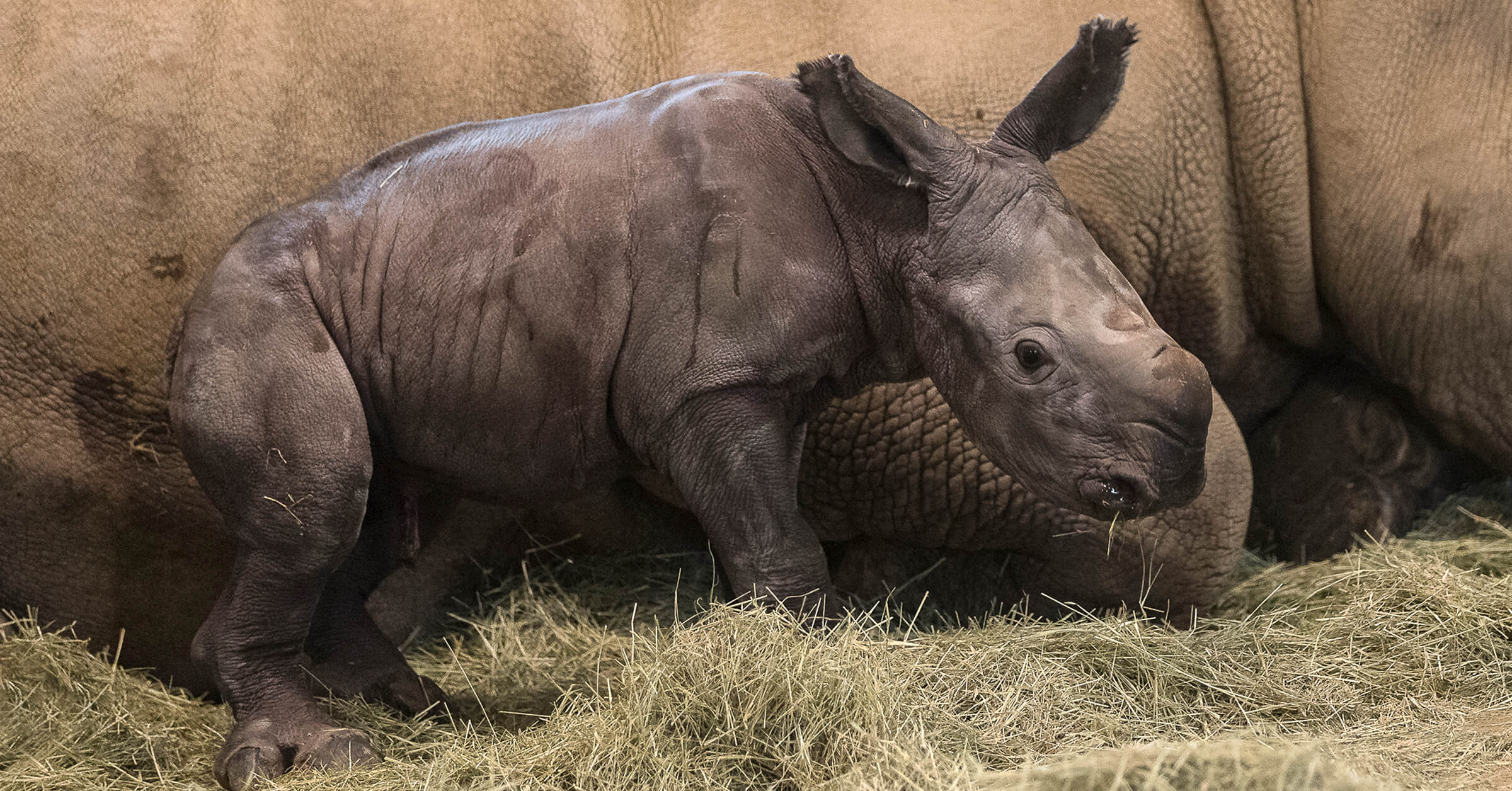
Countdown to a Baby Rhino
Victoria waited in a temporary holding area while we laid down the extra hay. And while she was waiting, her water broke! She was still up and walking around, so we moved her back into the birth area. She didn’t seem to want us moving around too much, so we stood quietly to the side.
I stepped out to collect the “birth kit.” This carefully designed kit has everything a wildlife care specialist might need during a rhino birth, including a stopwatch, notebooks, a camera, flashlights, gloves, and other supplies. With no further preparations to complete, we simply watched and waited. This was really happening!
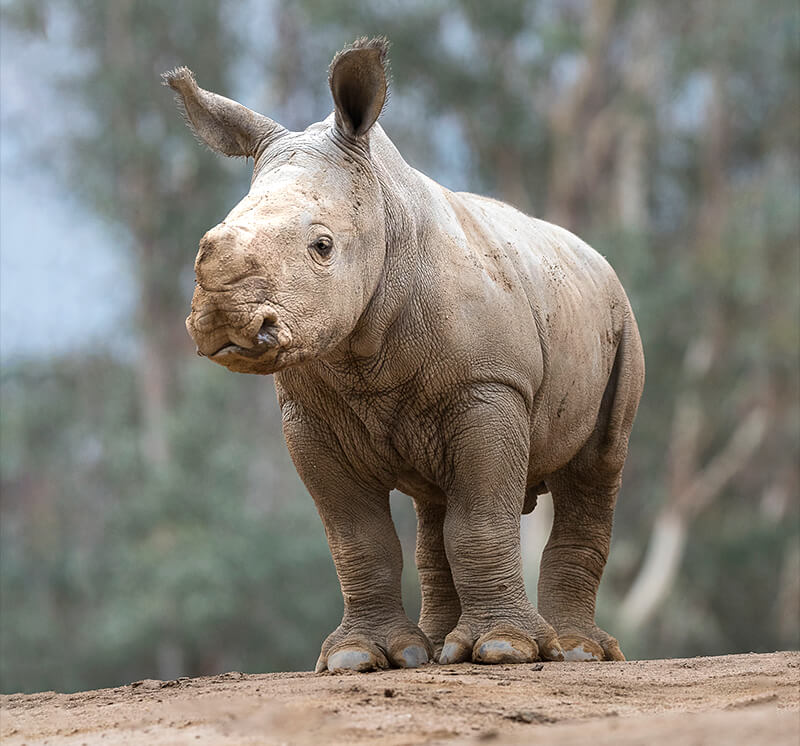
A CONSERVATION STAR
Edward is the 186th rhino born at the Safari Park, and the first southern white rhino born by artificial insemination in North America.
A Milestone in Rhino Conservation
Victoria was restless. She alternated between walking around and laying down on her side. At 5:31 p.m., stage 1 of her labor had officially begun. Even though we were ecstatic, we watched very quietly from the hallway. She laid down again on her side, and the calf began to emerge. We stood on our tiptoes, peering to see if the baby was positioned head first or feet first. We determined that it was head first—perfect!
At about 6:00 p.m., Victoria pushed a few times and the calf was born! She stood up and whirled around to look at her baby. I could see it moving! I was so excited!
Victoria looked at her calf in wonder. He used his gangly legs and giant feet to try to stand up. I’ll never forget the moment he saw the wildlife care specialists for the very first time. He looked at his mom, then at us, and then at the enormous world around him!
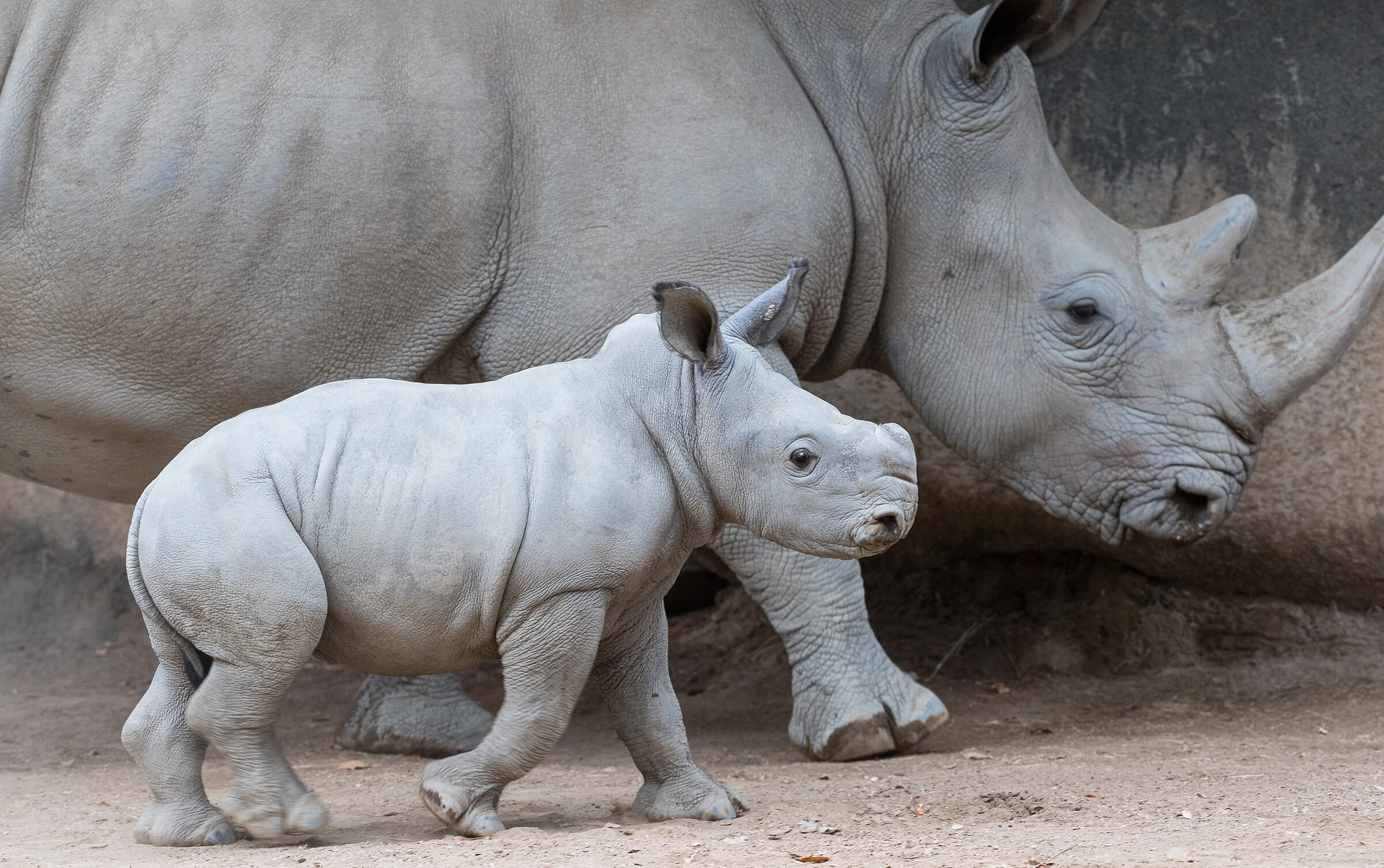
It Was Perfect
By 6:25 p.m. the calf had begun walking around Victoria, trying to nurse. He didn’t quite get it, at first—he suckled on her front leg for a while, then on her side, and even on her face! Finally, he made some little squeaks, signaling his hunger. This seemed to be just what Victoria needed to hear—she laid down and he began nursing! They have been inseparable ever since.
Edward is curious and silly. He soon approached the wildlife care specialists out of curiosity, with Victoria close behind him. She’s doing a great job at being a mom.
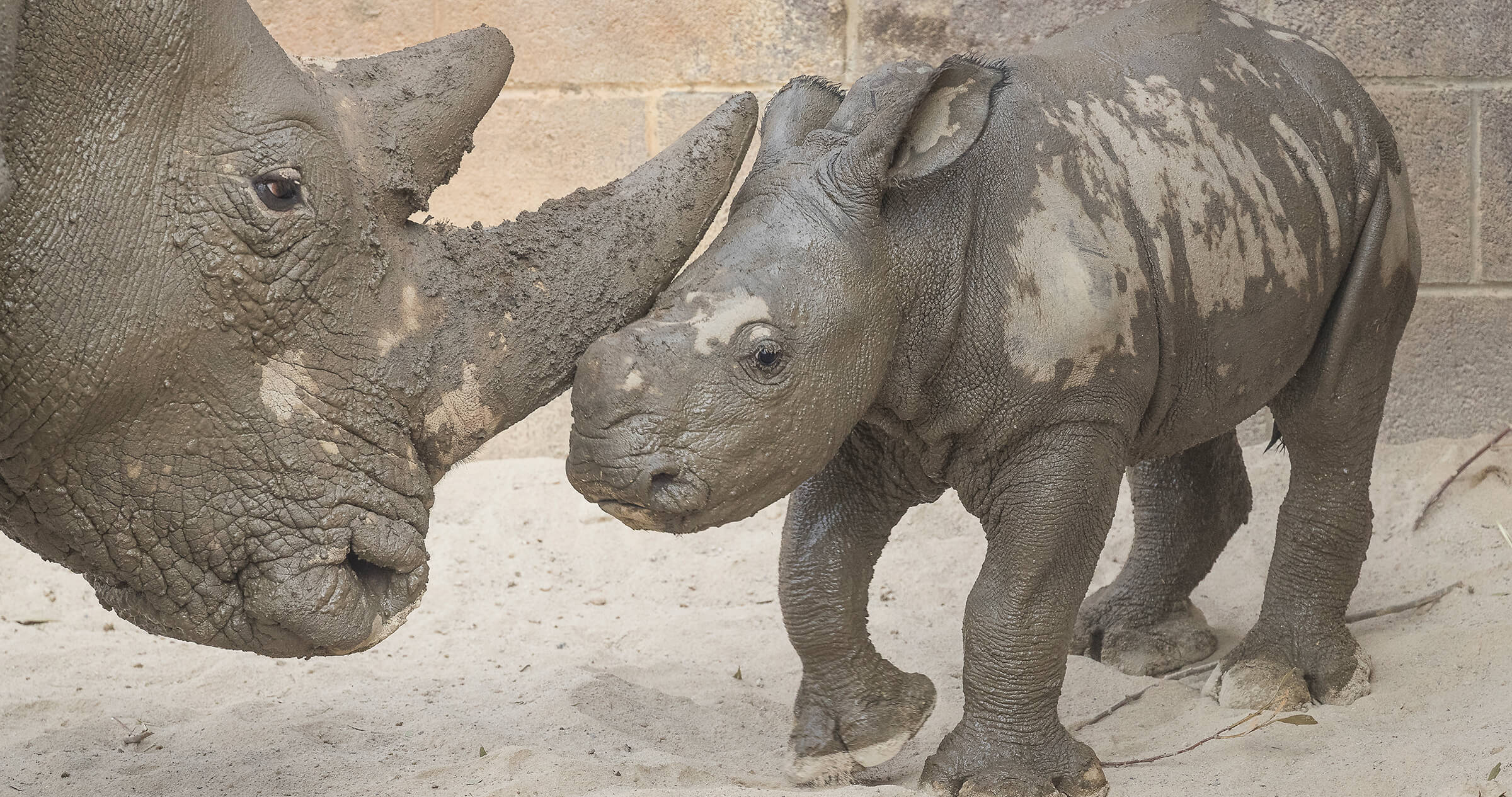
An Attentive Mother
When Victoria and Edward went outside for the first time since his birth, they napped in the sand pile, enjoying the sun. The weather was warm, so we made a new wallow for them. Victoria rolled and rolled in the mud, cleaning off and cooling down. Little Edward just watched her.
Then she did the most fascinating thing. She scooped up mud in her wide mouth and wiped it all over his back! Throughout the day, she reapplied more mud to him. Rhinos use mud to protect their sensitive skin from harsh sun and biting insects. No one I have talked to has ever seen this behavior before. Victoria is truly amazing!
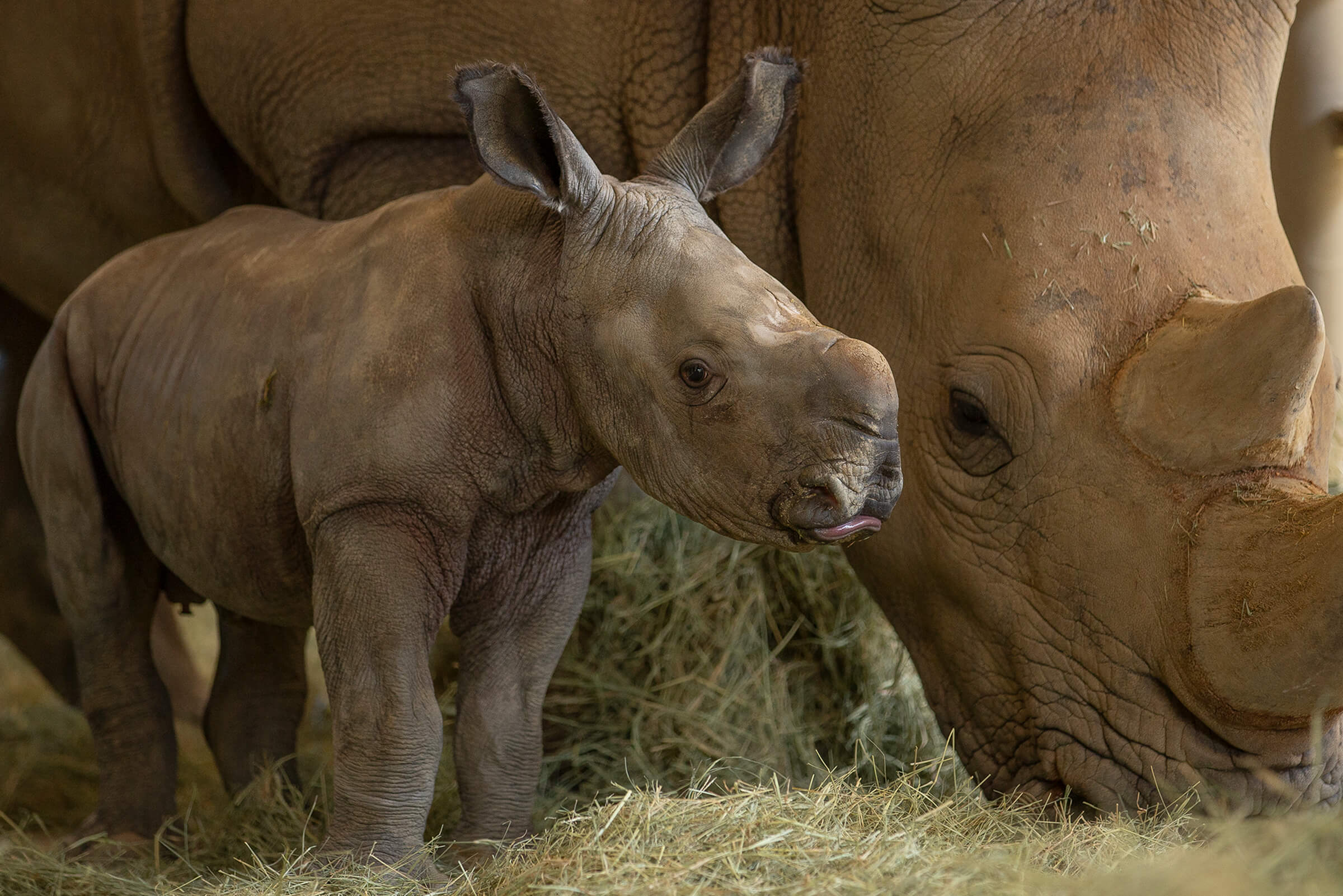
The Best Way to Start the Day
Victoria settled into her routine very well. When the morning shift wildlife care specialists arrive, we set out breakfast. Victoria munches away on a giant pile of hay, or some apples, while Edward comes over to check us out. He walks over to us boldly, head up, like he owns the place (I suppose he does, in a way). He seems very eager to investigate and get to know us.
What happens next is so sweet, it’s almost beyond belief. Edward stretches his smooth, gray baby face toward us. He looks at us with his deep brown eyes and twitches his fuzzy little ears. He might snuffle a bit. He seems to be asking for attention, but he’s just a little shy. That’s okay, though, because we know just what to do.
We shower him with scratches, all over his ears, neck, and back. If we find the right spot, he turns to mush. His back legs become weak and he squats very slowly, as if he’s enjoying the scratches so much that he can’t stand up anymore. After a minute, his head tilts back and he has to slump all the way down to the floor in total bliss. This is a typical rhino calf response to a good rub down—Edward continues to meet his developmental and behavioral milestones like clockwork.
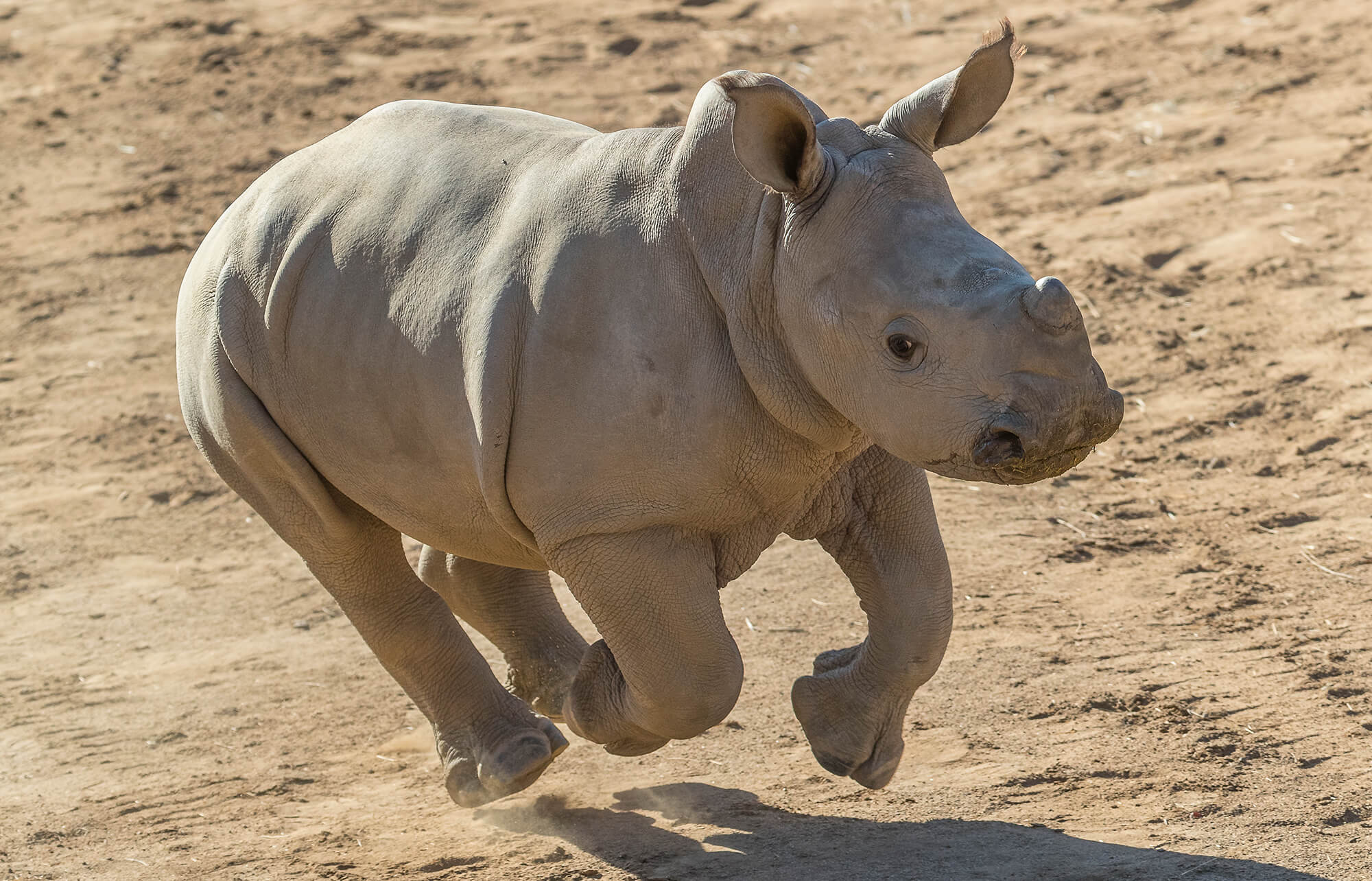
Edward’s Antics
Before the morning shift arrives to set out breakfast and give scratches, Edward likes to run around the yard at top speed. He’s usually at it when we arrive at 6:30 a.m. To me, he looks like a 200-pound puppy, galloping in pure joy. Eventually, his energy wears off and it’s time for a nap. Then later, maybe a mud wallow.
Edward is feisty and ready to take on the world. He spars with Victoria, charging her in play. She’s very gentle with him, and lets him win. Later, if she happens to be resting when he wants to play again, he’ll challenge anything that’s nearby—empty food tubs, basketball-sized rubber horse toys, it doesn’t matter to him. It’s so much fun to watch him learn and explore!
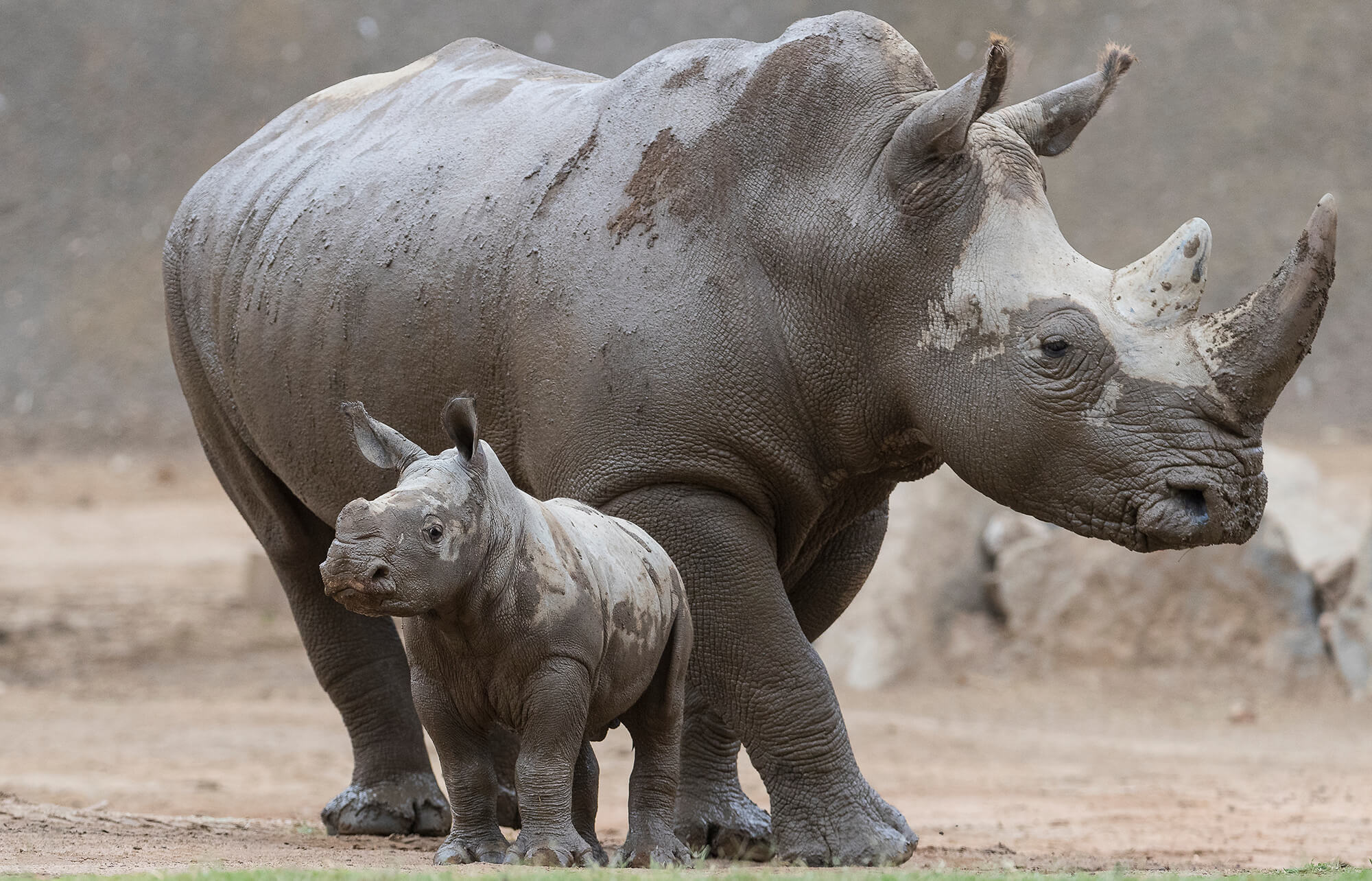
Mother and Son Dynamics
The relationship between Victoria and Edward is fascinating to watch. He’s confident and independent, and he regularly wanders away from Victoria, venturing across the habitat to investigate, checking out the other rhinos, or seeking out a wildlife care specialist to get some scratches. Soon, we will start introducing him to the other rhinos at the Rhino Rescue Center.
Sometimes, Edward’s sense of independence catches up with him. He’ll go inside by himself, realize that Victoria isn’t right behind him, and let out some pint-sized vocalizations—which are squeaks. That’s right: baby rhinos squeak! They sound exactly like a squeaky toy. Anyway, when Edward makes his high-pitched squeaks, Victoria responds the only way a mom knows how—by rushing to his side.
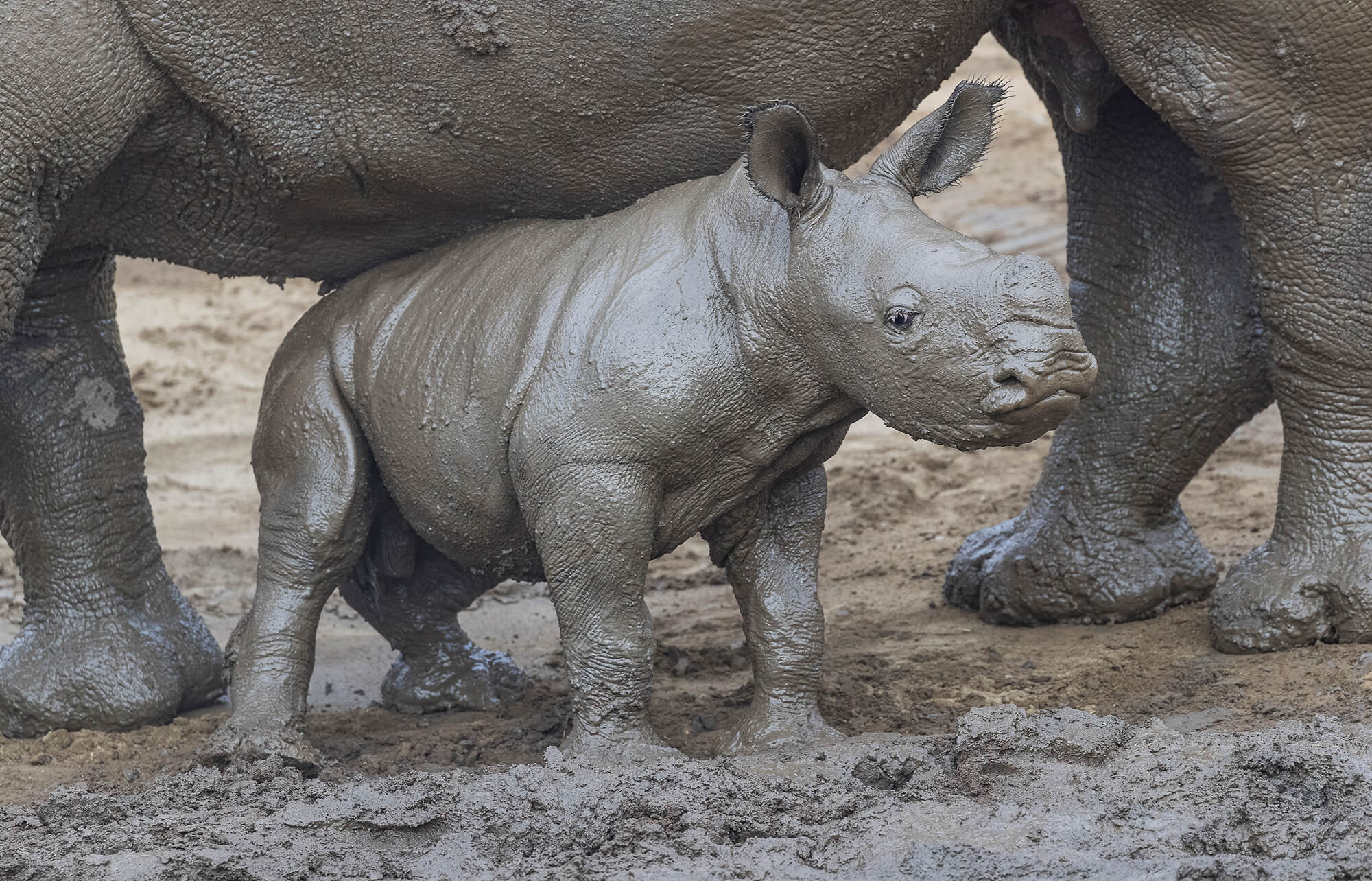
There’s Nothing Like a Good Wallow
Victoria and Edward liked their wallow so much that we made a bigger one for them. We scooped several tractor buckets of mud from the big yard and relocated it to their area. Before you start wondering why we’d go to all this trouble for some wet dirt, let me tell you that wallow mud can’t just be any old mud. We’re particular about the consistency.
Rhinos love to wallow—mud cools them off and coats their thick-yet-sensitive skin, acting as both sunscreen and bug spray. To be effective, the mud has to stick to them, coating them completely without running right off. We aim for the perfect ratio of dirt to water—the sweet spot is between thick/clumpy and thin/runny.
Initially, Edward was hesitant to try out the new wallow. But after a few minutes of investigating the edges, he committed. He laid down on his side and rolled onto his back, just like a pro! Even though it was his first wallow, he knew just what to do.
Just Like Proud Parents
Just like new parents, we are smitten with Edward’s every movement, development, and discovery. We take pictures and video. We’ll tell anyone who will listen about what cute thing he did today. Most of all, we’re bursting with joy that he has joined our family. Every time we introduce him to something new, Edward has an audience. Everyone at the Rhino Rescue Center gets to stop for a few minutes and enjoy him. He’s inspiring.
And he’s here with us because San Diego Zoo Global has a vision, a promise, and a fearless commitment to his species. Edward is the first southern white rhino born by artificial insemination in North America. He’s a symbol of hope for rhinos worldwide, and his birth is a critical milestone in our program to save his cousin, the northern white rhino. We are working hard to save rhinos, the much-loved gentle giants.

